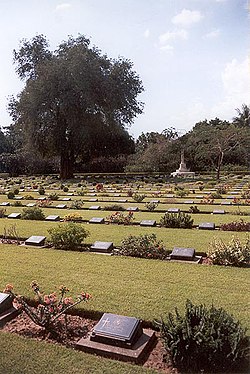Chungkai War Cemetery
 War graves cemetery | |
| Details | |
|---|---|
| Location | |
| Country | Thailand |
| Coordinates | 14°00′19″N 99°30′53″E / 14.0052°N 99.5146°E |
| Type | Military Cemetery |
| Owned by | Commonwealth War Graves Commission |
| No. of graves | 1,692[1] |
Chungkai War Cemetery, also known as Chung Kai War Cemetery, is a war cemetery in near Kanchanaburi, Thailand. Established in the 1950s, the cemetery hosts the graves of 1,426 British and 313 Dutch prisoners of war who died during World War II.[1] It was originally a prisoner of war camp on the Burma Railway.
Description[]
The cemetery at Chungkai hosts the graves of 1,426 British and 313 Dutch servicemen who died during World War II.[2] The majority of the interred died building the sections of the nearby Burma Railway. The cemetery is built on the site of a prisoner of war camp used by the Japanese army to house Allied POWs during the conflict.[3][4]
In 1946, it was decided to re-bury the Burma Railway deaths which were buried in many graveyards along the line in three large cemeteries. The current Chungkai cemetery is an extension of the existing camp cemetery.[5] American POWs were repatriated back to the United States.[6] The status of the Australian soldiers is unclear. One source describes Australians being buried at the cemetery,[7] while another states no Australians are buried there.[8] or that it only contains several non-military Australian prisoners.[9] The cemetery was designed by Colin St Clair Oakes.[10][1]
Camp Chungkai[]
Chungkai (also: Thai No.2 Camp[11]) was founded as a prisoner of war work camp. It was located 57 kilometres from the beginning of the line,[12] at the edge of the jungle near the Mae Klong River.[13] The first prisoners arrived in October 1942,[14] and were tasked to work on the bridges at Tamarkan and the section up to Wun Lun,[14] at kilometre 68.[15] One of the tasks was the Chungkai cutting, a railway cutting through solid rock.[13] In November 1942, a hospital was constructed at Chungkai.[9] Chungkai was considered one of the best camps with sufficient food.[14] The camp and hospital closed in June 1945. The hospital had treated 19,975 patients during its existance.[9]
See also[]
References[]
- ^ a b c "Chungkai War Cemetery". Commonwealth War Graves Commission. Retrieved 27 January 2022.
- ^ "Cemetery Details | CWGC". www.cwgc.org. Retrieved 2021-06-18.
- ^ "Chong Kai War Cemetery". www.tourismthailand.org. Retrieved 2021-06-17.
- ^ "THA. Chungkai War Cemetery". World War Two Cemeteries - A photographic guide to the cemeteries and memorials of WW2. Retrieved 2021-06-17.
- ^ "Graven van Krijsgevangen". Nieuwe courant (in Dutch). 8 June 1946. Retrieved 28 January 2022.
- ^ "Cemeteries". 2/29th Battalion A.I.F. Association. Retrieved 28 January 2022.
- ^ Hudson, C., 2009. Embodied spaces of nation: Performing the national trauma at Hellfire Pass. Performance Paradigm, 5(2), pp.142-161.
- ^ "Thailand POW Cemetery | COFEPOW". www.cofepow.org.uk. Retrieved 2021-06-17.
- ^ a b c "Chungkai Camp and Hospital Camp 60k - Thailand". 2/4th Machine Gun Battalion Ex Members Association. Retrieved 28 January 2022.
- ^ "Chungkai War Cemetery". www.roll-of-honour.org.uk. Retrieved 2021-06-17.
- ^ "Camplist". Netherlands Foundation for War Victims in the East. Retrieved 28 January 2022.
- ^ "Chungkai". Japanese Krijsgevangenkampen (in Dutch). Retrieved 28 January 2022.
- ^ a b Sears Eldredge (2014). The Tamarkan Players Present: Tamarkan Convalescent Camp. p. 186. ISBN 978-0-615-57445-5.
- ^ a b c "Chungkai". Far East POW Family. Retrieved 28 January 2022.
- ^ "Wan Lun". Japanse Krijgsgevangenkampen (in Dutch). Retrieved 28 January 2022.
External links[]
| Wikimedia Commons has media related to Chungkai War Cemetery. |
- List of British POWs buried at Chungkai at Commonwealth War Graves
- List of Dutch POWs buried at Chungkai at Oorlogsgraven Stichting (in Dutch)
- Burma Railway
- Kanchanaburi
- Buildings and structures in Kanchanaburi province
- Commonwealth War Graves Commission cemeteries in Thailand
- World War II cemeteries
- Cemeteries in Thailand
